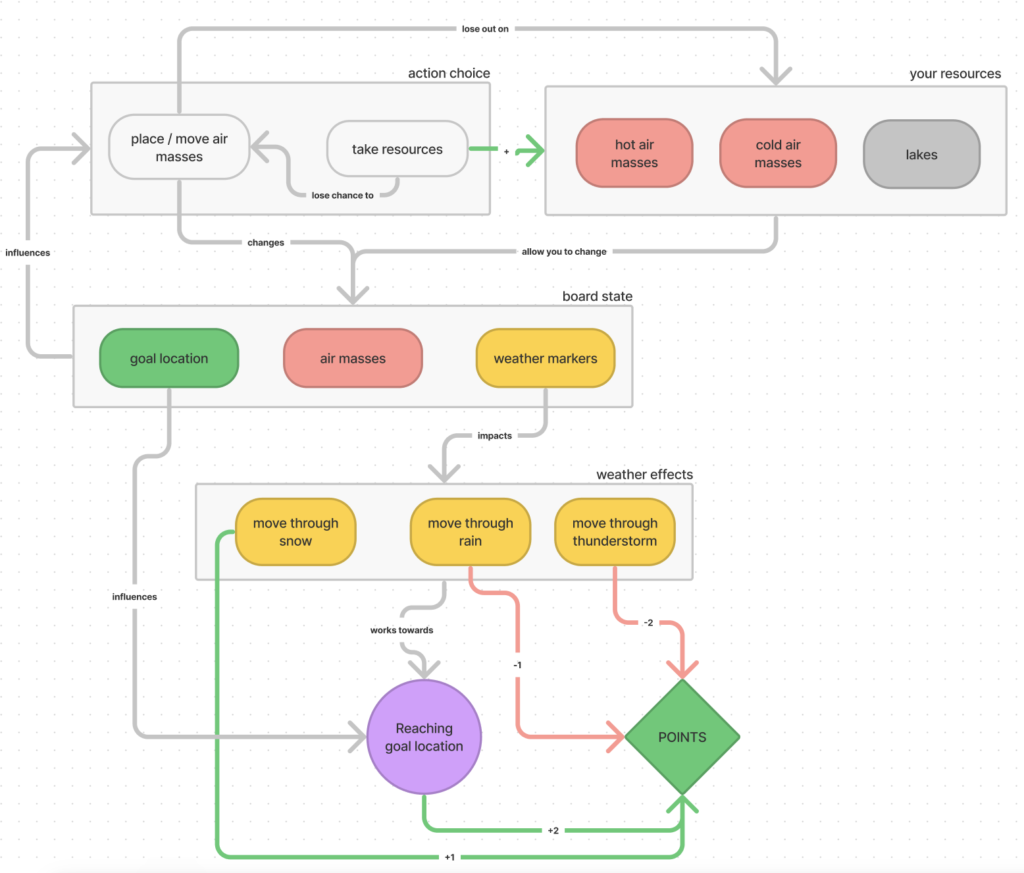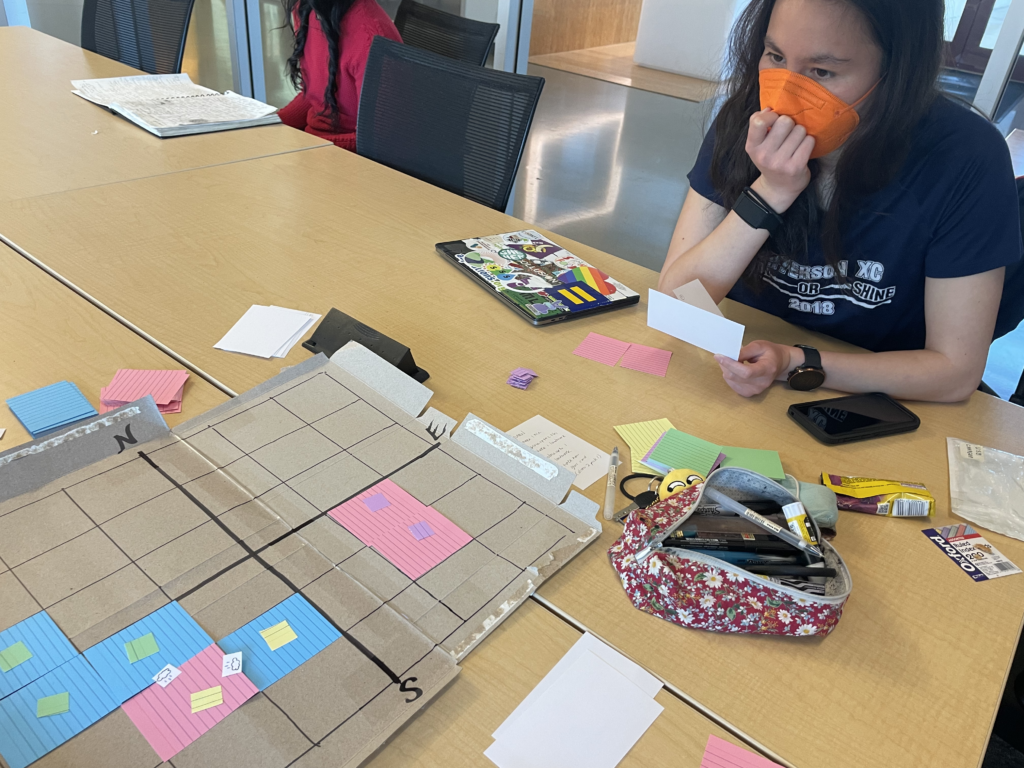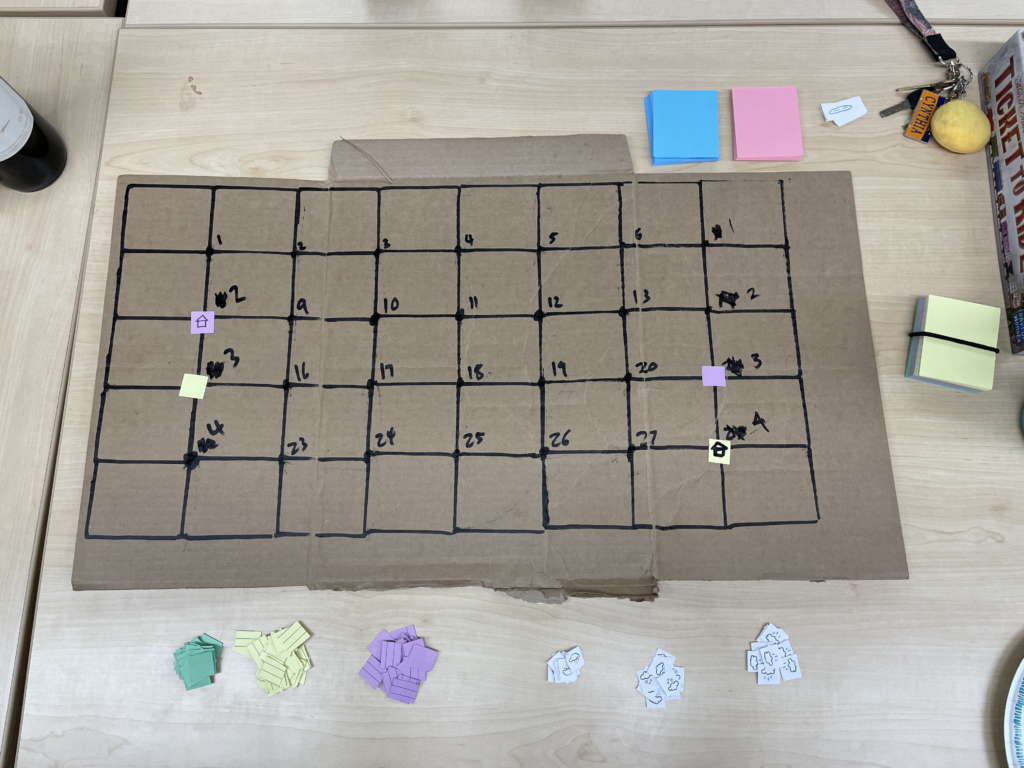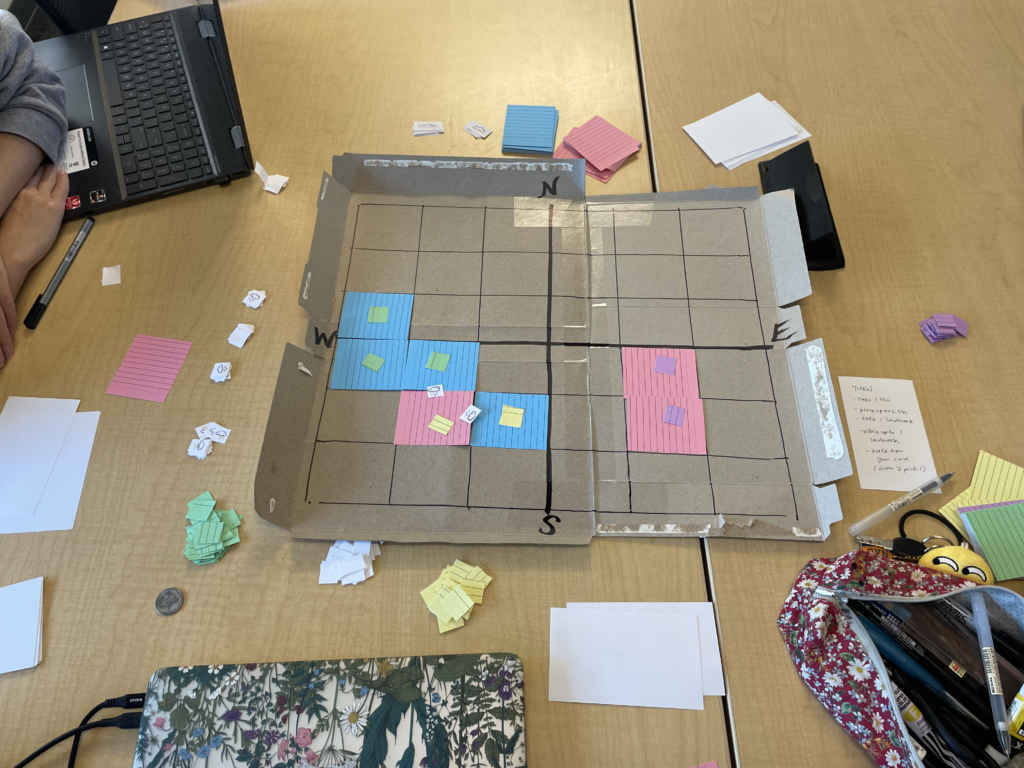A game by Cynthia, Rachel, and Vicky!
Artist’s statement
Weather or Not is a two-player competitive board game based around weather patterns created by warm and cold air masses. As players move back and forth across the board to reach their goal locations, they must understand how air masses interact to create fronts and precipitation. Players can manipulate air mass tiles to create favorable weather for themselves, or bad weather to thwart their enemy! Players must think ahead to create the right weather at the right time and place – WEATHER OR NOT they do will determine if they’re the winner!
Our ecosystem
Our ecosystem is weather, namely precipitation caused by fronts. Players will interact with the weather, affecting their point values and how they navigate towards their goal. As they add more air masses or lakes, it can affect the strategy players use to get around the board
What do we want people to learn?
We want to teach our players more about how weather forms! We were curious about this topic ourselves, so we looked deeper into it and realized that weather is complicated AF. In order to make things more digestible for our players (and for us LOL) we decided to focus on precipitation, and we simplified it into the basic idea of interaction of air masses. Teaching our players the way air masses collide to create fronts hopefully will give them some more understanding of the world around them, and a newfound appreciation for weather forecasters and weather scientists!
How do we accomplish this?
Because players need to understand how to create the weather necessary to gain points or to impede their opponent, they will hopefully internalize how air masses interact with each other to create weather!
Concept map

View the interactive / zoom-in-able file here: https://www.figma.com/file/BlzY1wffdhgLrpUp1lfXJu/Weather-or-Not!-Concept-map?node-id=0%3A1
Initial decisions about formal elements and values
Formal elements: Wanting this to be a multiplayer, competitive game. We wanted objectives around creating certain weather patterns, and whoever got the most points from the goal cards wins. We wanted resources in our game to affect how the weather patterns are made. The original conflict was trying to utilize the board space to your own advantage.
Values: Appreciation of how weather systems form, thinking ahead and strategizing.
Testing and iteration history


Version 1
Our first version of the game focused on placing permanent air masses and creating weather to fulfill goal cards. You could continuously draw and satisfy goals, similar to in Ticket to Ride. There were four different “regions” of the board where you could place air masses: NW, NE, SW and SE. The goals were similar to the examples below:
- place three warm air masses adjacent to each other (2 points)
- create rain in the SW and NE (4 points)
- have two thunderstorms on the same tile (5 points)
If you satisfy a goal card you would get points for it, but if you fail to satisfy it, its point value becomes negative. The game would end when the board is completely covered in air mass tiles, and the winner would be whoever has the most points at the end of the game.
Initial rules and mechanics:
- 2-4 players
- Each player starts by drawing three goal cards and keeping two
- Each turn a player can do one of the following:
- Take one resource (hot air mass, cold air mass, lake, or mountain)
- Place up to two air masses on the board
- Depending on the air mass interaction, a weather effect happens.
- If hot and hot or cold and cold masses touch, sunny weather will form
- If hot and cold air mass touch, flip a coin to see if it will either be rain or a thunderstorm
- Depending on the air mass interaction, a weather effect happens.
- Place a landmark on the board
- If it’s a lake on a warm air mass that’s touching a cold air mass, the weather at that front becomes snow (to mimic the lake effect)
- If it’s a mountain on a tile, rain at one edge of that tile could be reversed into sun (to mimic the rain shadow effect)
- Draw two new goal cards and keep one to fulfill
- The game ends when the board is full
We playtested this first version within our team.
Main findings:
- We wanted a way to reverse or change the tiles laid down – they felt too static and permanent, especially since in real life air masses actually travel
- We weren’t sure if it made sense to allow users to place landmarks, or to have them already on the board when starting
- Stronger theming was needed to motivate the goal cards – they felt kind of blah and arbitrary. Maybe we could have players be weather gods trying to protect their people?
- The difference between snow and rain felt random, so we thought it would make more sense to actually explain somehow that cold fronts (cold moving into warm) make more extreme weather like thunderstorms whereas warm fronts (warm moving into cold) would make more mild rain.
Version 2
The second version of the game is pretty different – we removed the goal cards entirely, and added goal locations that players would try to move to in order to gain points. We also focused on the mechanics of air masses interacting by allowing players to move them.
This second version makes the player more invested in creating weather, and especially creating weather to sabotage their opponent, because you can see where your opponent is trying to go.
Main changes made:
- Changed player count from 2-4 to just 2
- Remade board and added mechanic of moving both your character and your air masses, instead of just placing them. This makes the goal of avoiding bad weather more personal than the arbitrary goal cards we had before.
- Air masses moving into each other creates precipitation, rather than just being next to each other. This is more accurate to how fronts actually work!
- Air masses are removed after they interact with each other, which solved our previous problem of air masses feeling too permanent.
- 28 “goal” locations that a player could be assigned to with a random number generator. This got reduced down to 8 during the playtest (4 on either sided), because the 28 different locations made the score highly dependent on whether a player got lucky with the random number generator rather than actual strategy.
- Tried using a timer (similar to a chess clock) for each turn to add pressure, to mimic the pressure that meteorologists feel to get a weather forecast correct – the first person to run out of time first would lose 2 points and the game would end
Rachel playtested this version with one of her friends.
Main findings:
- The mountains that allowed players to remove precipitation didn’t make sense, because it only took 2 moves to get rid of precipitation, while it took 5 moves to create precipitation.
- The timer and 2 point penalty for running out of time didn’t really work, because it turned the game into a race to just get a 2 point advantage as quickly as possible.
Version 3
This final version wasn’t as drastically different as our V1->V2, but had a few changes. We tested this version at our game night, with Goutham and Alan.
Main changes made:
- Game ends when a player reaches 10 points
- Removed mountains
Main findings:
- Goutham and Alan were thinking ahead and had to make their moves carefully – this is great because it reassures us that there is some strategy and consequence involved.
- Goutham said he didn’t understand what to do at first and kept on saying he fucked up, so I wonder if we could have some reference cards to make actions more easily memorable for those starting off
- It seems easiest to just try and get points for yourself by creating favorable weather rather than messing with your opponent – are there ways to force more interaction between players?
- It could be fun to have some air masses or landmarks already populating the board, which would give the players more to plan around and interact with in the beginning rather than starting from scratch
- There still isn’t very strong theming – you’re just trying to avoid bad weather. But why? Who are you? Why are you moving back and forth? We needed to put a story on top of it.
Final game board and rules

Rules
Materials
- Game board
- Point pieces (green)
- Two player pieces (one yellow, one purple)
- Player marker pieces (yellow and purple)
- Cold (blue) and warm (red) air mass tiles
- Snow, rain, and thunderstorm markers
- Lake markers
Play
- Set up the board
- Generate a random number 1-4 to place player one’s goal piece. Do the same for player two at the other side of the board.
- Generate a random number 1-4 to place player one’s player piece, on the opposite side of the board as their goal. Do the same for player two.
- Take turns – on each turn, a player will:
- Move their player piece one space in any direction, but you are not allowed to move to the edges of the board. If you travel through any weather, apply the point effect (values noted below) and then remove the weather from that edge.
- If you travel through snow, +1 point
- If you travel through rain, -1 point
- If you travel through thunderstorm, -2 points
- Take an action. An action can be any of the following:
- Take a resource (cold air mass, warm air mass, or lake)
- Place a resource (cold air mass, warm air mass, or lake + warm air mass)
- Put one of your player markers on top so that you know this is an air mass that you can control
- Move an air mass that belongs to you to an adjacent square.
- If you move a cold air mass on top of a hot air mass, the edge they shared will form a thunderstorm
- If you move a hot air mass on top of a cold air mass, the edge they shared will form a regular rainstorm
- If you move a cold air mass on top of a hot air mass with a lake, the edge they shared will form snow (lake effect)
- If you move a hot air mass on top of a hot air mass with a lake, the lake will evaporate from the extra heat
- Move their player piece one space in any direction, but you are not allowed to move to the edges of the board. If you travel through any weather, apply the point effect (values noted below) and then remove the weather from that edge.
- If you reach your goal, +2 points for getting there. Then generate another random number 1-4 to place the goal token in a new spot on the opposite side of the board.
- Game ends when either player reaches 10 points. They are the winner!




